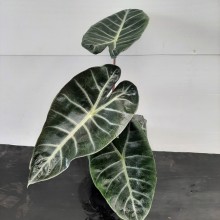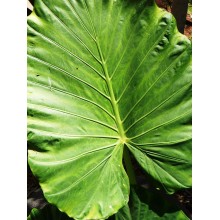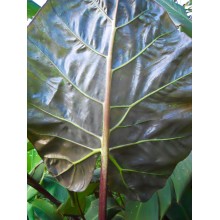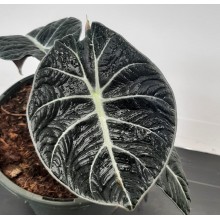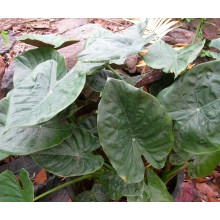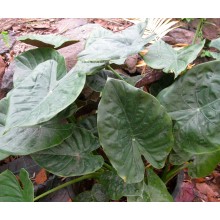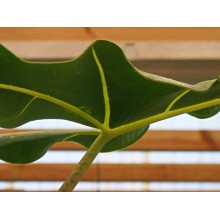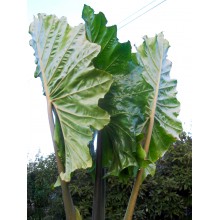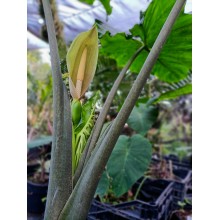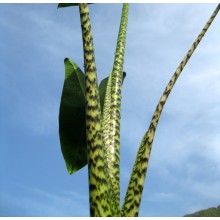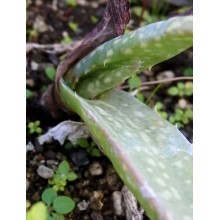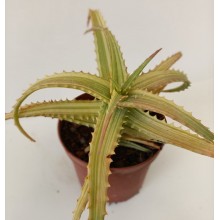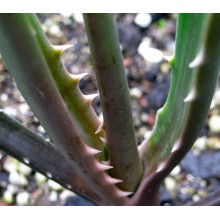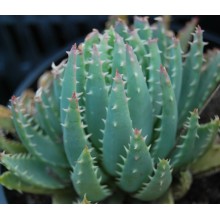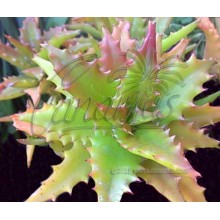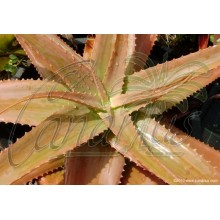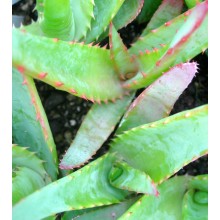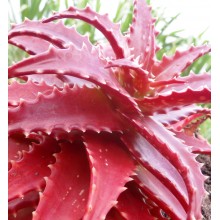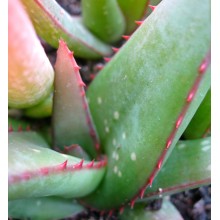Plantas generales Hay 1882 productos.

Si te gustan las plantas exóticas, acabas de llegar al lugar correcto. Canarius ofrece plantas exóticas difíciles de conseguir, que raramente se encuentran en tiendas de jardinería. Nuestra tienda tiene especies naturales, así como híbridos poco frecuentes. Ofrecemos plantas exóticas procedentes de las Islas Canarias.
Los pedidos se envían a cualquier lugar de Europa y también a todo el mundo. Los paquetes llegarán a su casa en pocos días después de ser enviados (tenga en cuenta que también necesitamos algunos días para el procesamiento). No dude en contactar con nosotros si tiene alguna pregunta.
Subcategorías
-
Suculentas
Los desiertos y las áreas secas son el hogar de las plantas más interesantes. Canarius ofrece una selección creciente de plantas suculentas de la máxima calidad, ya que han sido cultivadas al aire libre, bajo el pleno sol de las Islas Canarias.
Las suculentas o "plantas crasas" son especies que retienen agua, que están adaptadas a las condiciones de sequía. Estas plantas almacenan succum (jugo, agua) en sus hojas, tallos o raíces, y con frecuencia muestran un aspecto grueso y carnoso.
-
Exóticas
Las plantas exóticas son especies originarias de otras partes del mundo y que normalmente, tienen un carácter ornamental, una vegetación exuberante, con flores coloridas, formas inusuales... Aquí puede encontrar una gran variedad de plantas exóticas: desde bromelias y heliconias, hasta palmeras y plantas de interior.
Las plantas exóticas no tienen un uso específico. Los coleccionistas compran este tipo de plantas por su rareza, para decoración interior o exterior, en función de sus características. -
Frutales y Medicinales
Los árboles frutales, las hierbas y las plantas medicinales nos permiten mejorar nuestra salud y alimentación. En esta sección, cada tipo de planta tiene efectos saludables, tanto los frutales (Feijoa, piña, Fina de Jete...), como plantas para la salud, como Graviola, Aloe vera, Callisia fragrans...
En el metabolismo normal de todos seres vivos, el organismo produce algunas sustancias a partir de los nutrientes presentes en el entorno; algunos de estos químicos son parte del proceso en todo (o casi todo) tipo de especies. Normalmente, los componentes útiles están concentrados en algunas de sus partes: hojas, semillas, flores...
¡Encuentre su planta saludable y cómprela online!
-
Especiales
En canarius.com tratamos de ir más allá de los límites en el campo de la botánica. En nuestra tienda en línea tratamos de facilitar la compra de plantas de cualquier parte del mundo. Por eso, cultivamos desde las especies más comunes hasta las plantas más especiales, como podrá ver en esta sección.
-
Alocasia longiloba 'Pink Dragon'
Alocasia longiloba 'Pink Dragon'
Exceedingly beautiful tropical small Alocasia , with glossy deep green leaves, with prominent silvery veins and pink petioles. Its growth habit is similar to the more widely grown Alocasia x 'Polly'.
16,40 € -
Alocasia macrorrhizos - Elephant Ear Taro
Alocasia macrorrhizos - Elephant Ear Taro
This plant produces huge leaves that can attain 1,5 in a short time. It is a must for tropical-looking gardens but it can take quite a few degrees of frost. It grows well in the coastal mediterranean, with wind protection and abundat water. The stem has some itchy sap but it is edible if cooked for a long time.
23,40 € -
Alocasia plumbea Nigra
Alocasia plumbea Nigra
A classic of all times, this Alocasia has glossy and metallic dark leaves. They show unreal colours of purple to dark green or grey. It does not need hot temperatures to thrive.
26,70 € -
Alocasia reginula 'Black Velvet'
Alocasia reginula 'Black Velvet'
This is tiny gem with unreal foliage. Alocasia reginula is a very small Alocasia, most probably from Borneo, with black, light-reflecting foliage.
28,70 € -
Alocasia wentii
Alocasia wentii
"Hardy Elephant Ear" is a species of Alocasia that can take cold much better than others. It is native to high elevations in New Guinea. Leaf blades reach only 30-40 cm but they are purple-coppery beneath. It is fast growing, it does not require hot conditions and will sprout back after mild frost.
19,40 € -
Alocasia wentii Large
Alocasia wentii Large
"Hardy Elephant Ear" is a species of Alocasia that can take cold much better than others. It is native to high elevations in New Guinea. Leaf blades reach only 30-40 cm but they are purple-coppery beneath. It is fast growing, it does not require hot conditions and will sprout back after mild frost.
44,50 € -
Alocasia x 'Sarian'
Alocasia x 'Sarian'
This extremely beautiful hybrid was developed by crossing Alocasia zebrina and Alocasia micholitziana .
34,00 € -
Alocasia x Portora
Alocasia x Portora
Cold-hardy hybrid of unrivalled beauty. It is a man-made cross of Alocasia odora x Alocasia portei, developed in Florida. It bears magnificent huge leaves, and will survive to frost, to about -10 C. Leaves can reach 1.5 m in length and trunks can grow up to 2 m tall, giving a palm-like appearance.
28,90 € -
Alocasia x Portora- Large 100 cm
Alocasia x Portora- Large 100 cm
Cold-hardy hybrid of unrivalled beauty. It is a man-made cross of Alocasia odora x Alocasia portei, developed in Florida. It bears magnificent huge leaves, and will survive to frost, to about -10 C. Leaves can reach 1.5 m in length and trunks can grow up to 2 m tall, giving a palm-like appearance.We offer a plant with a height of 100 cm and a trunk...
68,90 € -
Alocasia zebrina
Alocasia zebrina
Very beautiful species that can also be used as a potted indoor plant, Alocasia zebrina is endemic to the island of Luzon, in the Philippines archipelago. Leaves are glossy, arrow-shaped, with upright zebra-striped petioles. An astonishing pattern!
36,00 € -
Aloe abyssicola
Aloe abyssicola
We offer a 8-14 cm rooted plant. This is a distinctive mid-sized aloe that grows on cliffs, in Yemen. Rosettes grow asymmetrically on a side, with beautiful, wide dull mottled leaves with widely spaced spines.
29,40 € -
Aloe arborescens 'Variegata'
Aloe arborescens 'Variegata'
This variegated clone of Aloe arborescens is just as easy to grow and to make it bloom as the true species, which is a popular ornamental shrub from South Africa. It just grows a bit slower and smaller. Leaves are jade-green, with yellow stripes.
34,00 € -
Aloe barberae - Large
Aloe barberae - Large
6 years - 60-70 cm tall. The largest of all aloes. This South African aloe tree grows as huge as a Dracaena draco and can attain 6-16 m in height. It takes light frosts and it is a must for Mediterranean gardens.
148,00 € -
Aloe brevifolia
Aloe brevifolia
Smaller leaved form of a low growing, clumping aloe. This dwarf form has a very manageable size and it is great for pots. This species from South Africa can stand some frost.
13,80 € -
Aloe buettneri
Aloe buettneri
Rooted plant, 10-12 cm diam. Cont. 8 cm. Nice, small, clustering aloe native to Congo. It grows as a dense groundcover and makes a nice potted specimen or even a hanging basket plant. It can stand low temperatures but it is better protected from frost.
14,20 € -
Aloe bulbilifera var. paulianae
Aloe bulbilifera var. paulianae
Rooted pup 12 - 18 cm diam. Aloe bulbilifera is different because it is viviparous: pups sprout from the inflorescence and grow larger when the red flowers are gone. This is the variety called paulianae.
15,20 € -
Aloe bulbilifera var. paulianae - Large
Aloe bulbilifera var. paulianae - Large
Rosette 30 - 50 cm diam. Aloe bulbilifera is different because it is viviparous: pups sprout from the inflorescence and grow larger when the red flowers are gone. This is the variety called paulianae.
22,70 € -
Aloe comosa
Aloe comosa
We offer a 13-18 cm diameter plant. This large stemmed aloe grows to a height of 1-3 m, unbranched. The bold rosette has a rusty-copper colour. It blooms with tall multiple spikes of red and yellow flowers. It is native to a small area close to Clanwilliams, e Western Cape.
15,20 € -
Aloe dorotheae - Large
Aloe dorotheae - Large
This is one of the most colourful low-growing aloes, a delightful garden plant with glossy cherry-red leaves when exposed to full sun. It is becoming increasingly popular in Tenerife, while it is critically endangered in the wild.
38,80 € -
Aloe elegans Ethiopia
Aloe elegans Ethiopia
Mid-sized stemless Aloe, widespread and locally abundant in northern Ethiopia and in Eritrea. It grows solitary or forming small groups. It grows on rocky slopes, mostly on sandstone or limestone, in areas with evergreen bushland or wooded grassland. This batch is from Ethiopian populations.
16,50 €
En estos momentos tenemos pocos productos en esta categoría Plantas generales




















